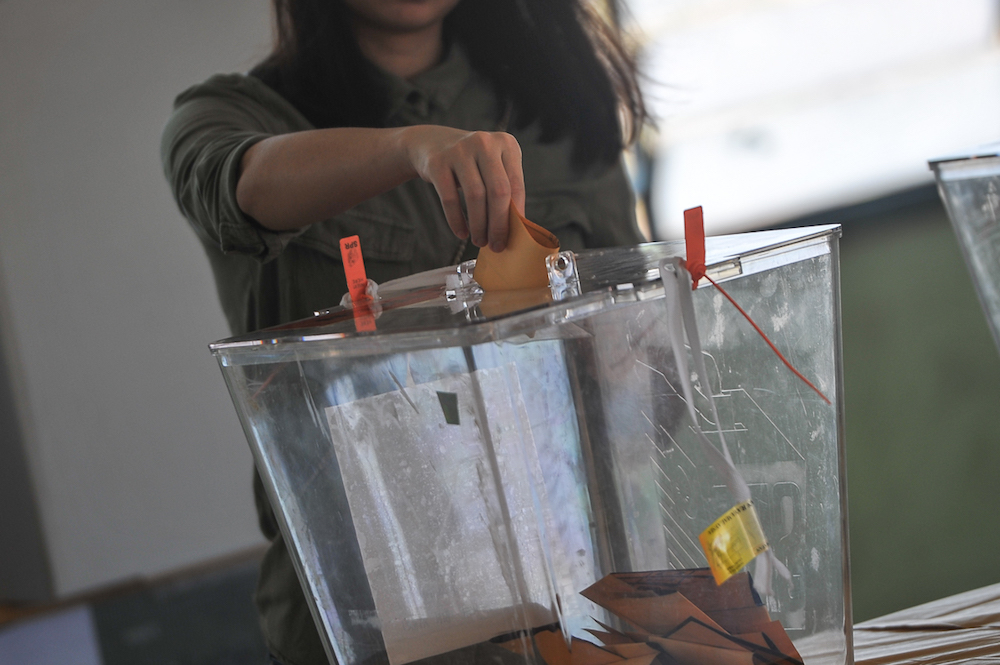
Sarawak’s Undi18 would mean another 135,000 voters to be added to the current 2019 electorate roll figure of 1,242,234, which represents almost 11 per cent of the total voter registration. – MalayMail photo

Edgar Ong
NOT many people were aware that on Sept 3, 2021 something of real significance had taken place in Kuching, Sarawak. It was on that day that the Kuching High Court had ordered the government to implement the Undi18 law; thus allowing some 135,000 Sarawakian youths aged between 18 and 20 to vote at the upcoming elections.
For the 13 or more so-called ‘marginal seats’ in the State Legislative Assembly (DUN), this new law could mean a major shift in electoral gains for the current Opposition parties in the state, as there is a widely-held belief that today’s youths would almost always side with the ‘underdog’ and are on the more ‘anti-establishment’ in their personal stand and political leanings.
Five youths had filed the petition after the government had chosen to delay the implementation of the law, which was passed in the Dewan Rakyat on July 16, 2019; and by Dewan Negara on July 25, 2019.
They were namely Ivan Alexander Ong, Sharifah Maheerah Syed Haizir, Chang Swee Ern, Tiffany Wee Ke Ying and Viviyen Desi George.
I say kudos and bravo to them all!
However, the Election Commission (EC) had, in March 2021, said that Undi18 and automatic voter registration could only be implemented after Sept 1, 2022, due to various constraints and issues. The chairman even had the audacity to use the excuse of ‘current developments and the Covid-19 restrictions having affected its plans’.
It appears to me that the current government in power, both at the federal and state level, would rather that the Undi18 be further delayed for as long as possible. It would seem that their common dread and fear of the youths of Malaysia turning up in full force at the polls to cast their votes could and would decide their political future – and rightly so, they should too!
Sarawak’s Undi18 would mean another 135,000 voters to be added to the current 2019 electorate roll figure of 1,242,234, which represents almost 11 per cent of the total voter registration.
We can take it that at least 80 per cent of this number would turn up during election day – or vote by post if they’re away.
Sarawak’s population has seen a slow growth, with some constituencies experiencing even minor depopulation. Its population, in total, has only grown 1.7 times since 1991; in the 2018 estimate, 55 per cent of the total resided in the districts of Kuching, Bintulu, Miri and Sibu – an increase of urbanisation of seven per cent since 1991.
Three districts, in particular, have experienced extraordinary growth in their populations; Samarahan has grown by three times, Bintulu 2.5 times and Miri, 2.2 times, since 1991 – within a period of only 27 years.
In a survey done and conducted by ‘Tindak Malaysia’ in 2020, it is commented: “While the population has grown strongly in the more urbanised districts, Sarawak has been experiencing a severe malapportionment among state constituencies, which disadvantage urbanites. The implication of the then redelineation proposals of 2015 would grossly reduce voter value for Sarawakians who reside in urban areas. In 2018, approximately 58 per cent of Sarawakians reside in urban areas.”
In terms of race and ethnicity statistics for 2017, it had shown that the Iban community constituted 29 per cent of the total population of Sarawak (the Iban-majority seats number at 21, which represents 26 per cent of total seats); Malays accounted for 23 per cent (29 seats and 35 per cent of total seats); Chinese at 22 per cent (16 seats and 20 per cent of all seats); Bidayuh at eight per cent (six seats and seven per cent of all seats) ; Orang Ulu at six percent (five seats and six per cent of all seats) and five mixed seats (six per cent of all seats).
(*In the population statistics, the Melanaus accounted for five per cent; other indigenous communities six per cent; Indians and others, one per cent; and non-citizens, six per cent.)
From these statistics alone, one could immediately see that the Malay and Melanau communities are over-represented in DUN Sarawak’s composition, while the Iban community is under-represented. The Bidayuh and the Chinese are slightly under-represented as well.
Quoting again from Tindak Malaysia’s analysis of the past three state election cycles at DUN Sarawak level, the overview showed an evolving electoral and political scenarios of Sarawak from 2006 to 2016 – as over the years, we had had three different chief ministers, new political alliances had been created, and the 2015 redelineation exercise had seen the addition of 11 new state constituencies.
We have also seen the Opposition parties of DAP and PKR having made some inroads as well as suffering minor setbacks too.
According to analysis, there are at least 13 closely-contested state seats of which fortunes would and could turn at the very final 11th hour – and the winning majorities could be as small as just double-digits. At play this coming state elections would be these seats: Tasik Biru, Kota Sentosa, Batu Kitang, Batu Kawah, Repok, Dudong, Bawang Assan, Pelawan, Piasau, Pujut, Senadin, Telang Usan and Ba Kelalan.
There’d be the seats that would be hotly-contested and see heavily-charged political campaigning in the weeks and days leading to polling day itself. Historically the underdog, the Opposition, would be favoured to win in these seats, but upsets have been known to also happen.
If history repeated itself, it would be an uphill battle for the Opposition group of allied parties or any independent to ‘upset’ any of the rural seats traditionally held by the PBB group – mainly in the Malay and Melanau heartlands. Sarawak voters of both these ethnicities have been used to voting in the ‘government of the day’ since elections had started – is it a British colonial hangover or a ‘curse’?
Has it been the common faith, religion that had united them; or has it simply been because these voters have not known anything else and are content with their lot; for in the ‘kampongs’ and villages, there’s very little much else that they can desire for other than the bare necessities of life?
The forthcoming electoral battle would be fought in the Iban, the Bidayuh and the Chinese constituencies. However the ‘deep pockets, the mighty election machinery and the clout’ as well as the overbearing ‘Godfather’ imagery and guess what – the ‘last-minute goodies’ that would surely be doled out to the voters in the remote rural districts, which are unreachable by the Opposition, would make all the difference – once again!
I don’t expect that most of the newly-anointed Undi18 voters would be able to make it – the majority of them might be registered at place of birth, and are now studying or working elsewhere and it’d cost a small fortune as well as disrupting work schedules to travel back to their home bases to vote.
Even if they could make it, would the numbers be enough to make a difference?
It’s still a much loaded dice. Roll it soon before the year’s out, and we’d most likely see the same old faces come the next newly-formed session of DUN.
It would take time, and a lot of work – hard and tiresome, lonely and unrewarded, and mostly unappreciated – to get the Undi18 voters out to vote and make a difference.
But we all have high hopes, and we can all pray for miracles to happen.
Who knows, we might still be around to see the day when change would finally arrive at last in our Fairland Sarawak!
God bless Sarawak – may God keep you safe, peaceful and always in harmony.
[I would like to make a correction to my column last week, with regard to the paragraph pertaining to the mooncake episode and the mention of the demise of a former classmate; I would like to state here that my ‘other classmate’, Vincent Tsan Hiang Yong, the son of the original Chin Hiang Chay, is very much still with us today! Long may he live and prosper. Praise God!]
